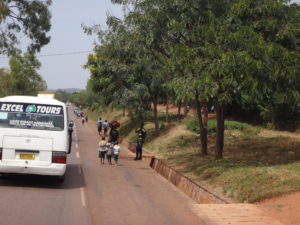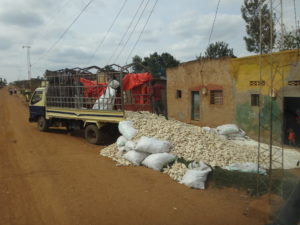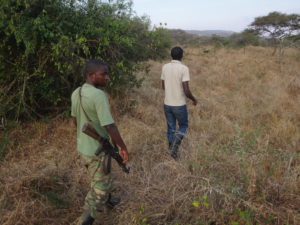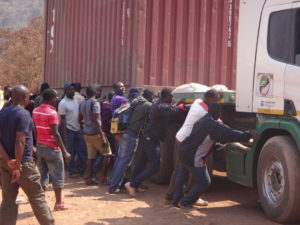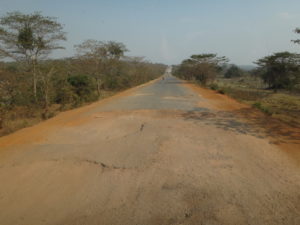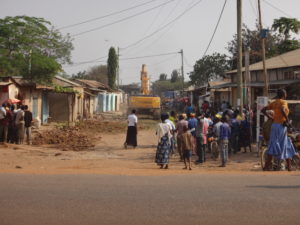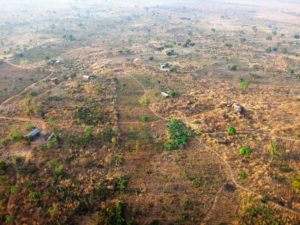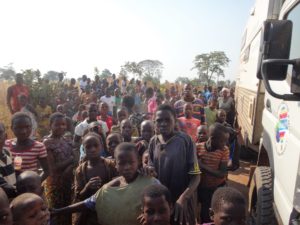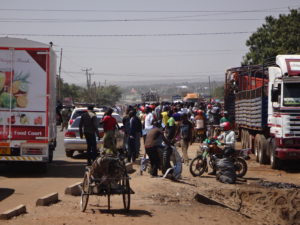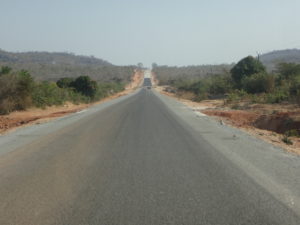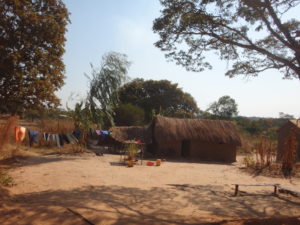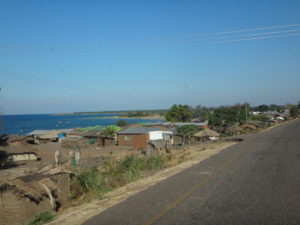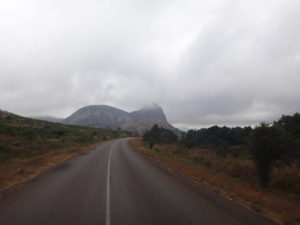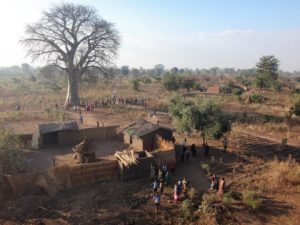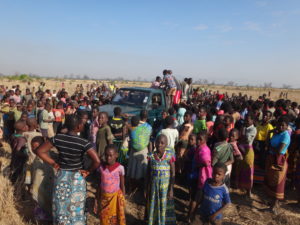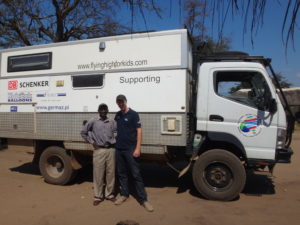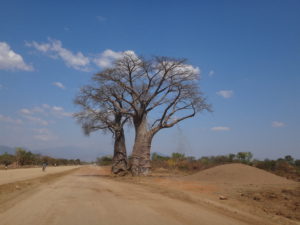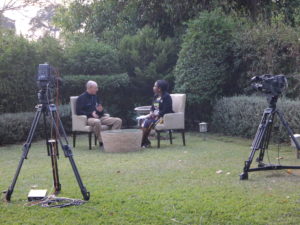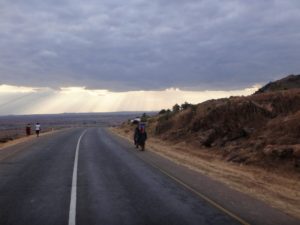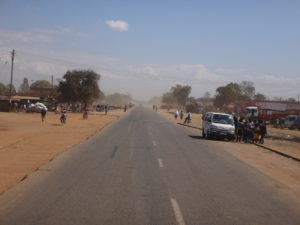Rwanda to Zambia 6 July – 1 August 2017
Adventures In Africa 18 May-6 July
July 5, 2017Zambia and Zimbabwe
September 3, 2017It was an easy couple of days in Rwanda’s Capital, Kigali, catching up on lots of things, such as planning and blog writing. I found a big carpark close to the airport, which acted as a good base.
I left Kigali for the Akagera National Park. The road was easier than expected through the hills and I made good time. There was a problem with the phone network at my destination, which meant I couldn’t get hold of my contact, Emmanuel. I wasn’t sure I was even in the right village as there were no signs and it wasn’t marked on the map I was using. I asked a passing truck driver, who confirmed I was in the right place.
Emmanuel knew the approximate time of my arrival, and just as I started down the road, aguy waved out to me from a motorbike: It was Emmanuel.
We went directly to the school I planned to fly from. Emmanuel needed to get permission from the head elder that it was OK for me to visit. There are a series of protocols which must be adhered to when visiting schools. As we were driving there, we received word of more permissions needed by the Rwanda Civil Aviation Authority needed. We got to the school, I had a quick look at the site, and then headed to the national park, about 45kms away. The Park Manager all ready had some dealings with the CAA, so took it up for me.
For the following five days it was back to the simple life, at the exit post inside the park. It was great to meet the rangers, guards and fence maintenance workers, (who walk 25kms a day making sure the fence hasn’t been broken). We cooked on an open fire and went for a couple of walks with the rangers. There was surprisingly a very weak internet signal, so I did have access to internet, albeit slow.
I hadn’t carried much food with me, so I went to the nearest village one morning, around 15kms away. There wasn’t much to choose from, only the very basics such as bread, milk, eggs, tomatoes, beans and rice. Funnily enough you can always seem to buy Coke or other soda drinks wherever you go.
One of the highlights of my stay was seeing a Leopard walking close to the post. It seemed to walk the same track just after sunset, but not everyday. I also saw Zebra, Warthogs, Waterbuck and lots of bird life.
It became apparent that I was not going to get the flight permission in time, so I had to abandon the idea of flying in Rwanda, which was disappointing after so much work had been put in over the past few months. I would probably have received the permission a few days after I left, but I was out of time.
I got permission to drive through the National Park, in the opposite direction to usual. One of the fence maintenance guys came with me. It took around 5 hours to drive through. It’s a beautiful location. I didn’t realise it was quite so hilly. We saw lots of animals, including elephants and giraffe. They have recently re-introduced rhino, but they are very rare to see. The track was rough in some areas, and it really felt like we were in the back of beyond. We only saw a couple of other cars the whole way. It’s a beautiful drive looking down on rivers, crossing plains and traversing hills. The park runs along the Tanzania border.
We arrived at the National Park Headquarters after dark. I met with Joseph, one of the management. We had an interesting dinner together in the canteen that evening.
I left for Tanzania early the following morning. The drive through the mountains on winding roads was beautiful, passing people busily working the rice paddies on the flats and through the many villages in the hills and mountains. There are also the impressive Rusumo Waterfalls on the Rwanda/Tanzania border.
The border crossing buildings look new and are very well organised. It was quite empty. I had to pay US$126 road tax for Tanzania because of the size of my vehicle, which I was a bit shocked about. They wouldn’t accept that it was a motorhome. The visa was easy to get and all up I spent around 1.5hrs on the border.
The road into Tanzania started OK, but it became a road with terrible potholes in parts. On one steep hill, two trucks had completely spun out and were blocking the road. It took around 1.5hrs until one of them could back up and let people through, (I’m not sure why it took so long to come up with that idea). At one point about 50 of us tried to push the truck, but there was no hope.
It was interesting to talk to some of the truck drivers. Being a truck driver in Africa is hard. Many were travelling from Arusha into Rwanda or Uganda. Some domestic drivers only get around $US50 a month.
I also met a Dutch diplomat from their embassy in Kenya.
I arrived into the town of Runzewe that evening after a tiring afternoon of driving through suspension-breaking potholes. I ate at one of the local street stalls and searched for a place to park up. The best place was a 24hr fuel station, so I asked the guys there if it was OK. They asked me to pay a couple of dollars a day, which was fine by me. One armed guard even sat outside my truck during the night.
I chose Runzewe to fly from after doing some research on wind patterns. I knew no one there, so I expected it to be a bit of an adventure. It’s a transit town of about 30,000 people with nothing very special about it, except it looked like a good place to fly.
I stayed for five days and whenever I’d walk down the street, I would always hear “Muzungu, Muzungu”, which basically means “Traveller” in most of East Africa, south of Kenya. It’s a common term used for foreigners.
I made friends with the owner of the internet cafe, plus the workers at the service station, and a number of shop owners. Everything was very basic, including the range of food. No one bothered me, but I certainly created a lot of interest wherever I went. I think it was rare for a foreigner to stay in town.
I worked on the flight permission with the Tanzania CAA, and they granted it a couple of days before the flight. I must say that they have been one of the best CAA’s to deal with in Africa so far, and I even spoke a number of times with the Director himself.
The day before the flight, I went and spoke to the police as a courtesy. They seemed to be all fine with it. Later in the afternoon, I met with the owner of the internet cafe. He was a teacher at the school I was going to take off from. He informed me that the police had been in touch with him and they wanted me to seek permission from one of the regional mayors. I called him, and he said that I should speak to someone even higher than him, as they wanted to inform the region that there would be a balloon flying. It was getting a bit crazy. I thought I would have to call the President of Tanzania next.
I called the next guy and told him what was happening. He seemed to be OK with it, but said he would be in touch later as he had his daughter’s graduation. As it was all ready 5.30pm, I wasn’t holding much hope. I decided that no one had actually been against what I was doing, plus I had the permission to fly, so I would just go and do it.
On the morning of the flight, I got one of the service station’s security guards to come and help me, (and fly with me). We went down the road and found a place to take off from. There was a cement works down the road and a good field just across from it. A number of security guards from the cement works were milling around, and a couple came over and helped out.
We got up and away without any problems just after sunrise. We travelled at about 25km/h. It was interesting to see the farmland around and how undeveloped it was. We flew over a number of huts. Most of the people were terrified when they saw the balloon and ran away. I can’t imagine what they were thinking. It really felt like we’d gone back in time, the area was so isolated with not many signs of modern development.
After around 45mins I found a place to land, and tried to stay away from the village as I knew there would be mayhem if I flew over it. I landed right by a track, (the only one since we’d taken off which you could get a vehicle down), about 500m from the village. A couple of minutes later you could hear the villagers coming down the track. I had no idea how they were going to react, and was pretty keen to get the balloon down. As it turns out they were very happy to see us, and I was very happy to have the security guard with me who could translate. A few hundred people came to have a look. We managed to get the balloon packed up and I asked one of the motorcyclists to take me back to get the truck, (which was left back in the field in Runzewe).
The track was not as big as I thought, but luckily just big enough to get my truck to get down. The motorcyclist dropped me off and I headed back with the truck and managed to find the balloon, still with many people around. A number of the guys helped to load the balloon. The whole experience was quite amazing.
Immediately after the flight, I dropped the security guard back at the service station, said goodbye to everyone there, and headed for Malawi, around 1500kms away, through the heart of Tanzania. The road was good tarmac for a hundred kilometres, before going onto a reasonable dirt road for another 50kms or so, before going on to good tarmac again. After the city of Tabora, I found the roading crew who were sealing the road going south, which meant the perfect road ended and it was onto a terrible, hard, corrugated, potholed road. It was not fun at all.
I managed to find a lodge to park up that night in Sikonge and had dinner in one of the restaurants there. It was a good place to spend the night and the locals were welcoming.
I knew the following day was not going to be fun. The aim was to get back onto the tarmac by the end of the day, 400kms away. The road was bad for about another 50kms before I was pleasantly surprised to have a smooth dirt road for about 100kms. It was a beautiful drive through a huge area hardly inhabited by people. I saw about 10 vehicles and five huts the whole way across. It really felt like I was in the middle of nowhere and I really enjoyed it. I could even travel about 80km/h.
All good things must come to an end though, and I again met the hard, rocky, corrugated, potholed road, which got worse and worse. I had to crawl through some parts, especially in the hills. The road was reduced to a single track and I was wondering what I had gotten myself into. I was alone in the middle of nowhere, bush fires sometimes right by the road, (it seemed the whole place was being burnt off) no phone signal, and on the worst road I’ve ever been on.
One of the air horns fell off, so I had to re-attach it with cable ties, plus I started to hear a strange knocking sound, which I couldn’t identify where it was coming from. The truck was really getting a bashing. There was some reprieve when I got to a more inhabited area after the hills. The dirt road was quite good for about 50kms, before turning back into a hard, potholed and corrugated road again. I assume they put fist-sized, (or bigger) rocks on the road to make it passable in the wet season. The road is so compacted and hard it doesn’t have any give at all, so the truck felt like it was shaking itself apart. I thought about reducing the tyre pressure, but I ran the risk of denting a rim.
A couple of times a wheel got caught in sort dirt on the side of the road, (avoiding big holes), and I would suddenly veer left and come to a stop. Luckily I wasn’t going very fast enough and it caused nothing more than an inconvenience. I would reverse and continue on my way again.
After a 10 hour drive, I was extremely happy to see the tarmac at the end of the day, and I stayed in the town of Chunya that night. There was had a very good and well supplied restaurant, so I enjoyed a nice meal that evening.
The trip to the border the next morning was very scenic. After a bit of a climb, there are amazing views of the valley below before reaching the city of Mbeya. You continue through more mountains before reaching the Tanzania/Malawi border.
The border crossing on the Tanzania side was easy, but due to a huge line at the bank, (to pay for road tax), I spent a good couple of hours on the Malawi side. A truck was trying to park, but got a leak somewhere in the power steering system, and dropped all its power steering fluid on the road. It took two guys using all their strength to turn the steering wheel for about 25mins to manoeuvre it into place. This meant that no one could come or go during that time as they blocked the whole road. Luckily it wasn’t too busy though.
It’s pretty easy driving heading into Malawi. The roads are good, some newly resurfaced. The driving is flat as you pass the very blue Lake Malawi. it’s a beautiful sight. You head inland after a while, and into the mountains and down a narrow valley, which enters a much wider one. I hoped to find a spot to park before dark, but I couldn’t find one, so headed for the nearest large town, Ekwendeni. I parked up in one of my favourite places: a service station. I paid the guards a few dollars to park there for the night. One of them even took me down to a restaurant for dinner. It was pitch black at that stage.
I made the trip to the Capital, Lilongwe, the next day. I was quite taken by Malawi’s beauty. I didn’t know much about the country before visiting, so was impressed by Lake Malawi, the mountains and natural landscapes. It was quite cold travelling through the mountains, helped by the low cloud and strong wind. I was even contemplating turning the heater on.
I arrived into Lilongwe in the afternoon and visited the South African High Commission to ask for information about applying for visas. The person was busy though, as all visa processing is done in the morning.
A friend of mine had arranged for me to stay at a family member’s guest house. He met me and led the way there, battling the rush hour traffic along the way. I had a good meal at their restaurant that night.
I headed back to the South African High Commission the next morning, only to be told that I would have to go back to my country of residence to apply for a visa, and there was no way around it. It was not the news I wanted to hear as it would meaning changing my whole schedule.
I went back to the guest house and decided to investigate the knocking sound coming from the truck. As it turned out, I couldn’t even lift the cab to get to the engine. It was completely jammed. A few guys tried to help me release it trying different methods for a couple of hours, but it wouldn’t budge. Fortunately there was a truck mechanic just across the road, and we decided we’d have to butcher the hooks which were stopping it from lifting. They were cut off with a grinder, but we still couldn’t get it up by the end of the day.
The owner of the workshop, Fletcher, said I could stay there the night if I wanted. We went to have ice cream with his friends in the evening and he returned something he had borrowed to another friend just outside of Lilongwe. On the way back, we ran out of petrol, so we had to wait for around an hour until his Brother came out with petrol.
He took me to meet his Fiance, who made us a very nice dinner. After dinner we went to a bar his uncle owned in ‘the hood’ and we played a few games of pool. It was a great place, and an interesting way to experience real local life. I wouldn’t go to the area alone I don’t think.
The whole next day was spent trying to fix the cab. We also spotted a crack in the chassis in front of the front wheel; very bad news indeed. I went with the mechanic to a market to buy welding rods and various items, and picked up a big welder from his friend. It was welded up, but I will need to get it properly fixed in Botswana or South Africa. The cab still wouldn’t close properly, but we managed to lock it on one side. It seems the chassis is slightly bent, but further investigation is needed. The road in Tanzania really took it’s toll.
Fletcher again took me to his wife’s place for dinner, and we played pool at the bar again.
We said our goodbye’s the next morning. Fletcher hardly charged me anything for the work. I was so impressed by everyone’s hospitality and willingness to help in Malawi.
I headed south to Nanthomba, a small village next to Liwonde National Park. I was due to fly there the next morning from the local primary school. I met with the Principal, a few teachers, and the Children in the Wilderness co-ordinator for the area, Christopher. I am co-operating with them in a number of countries in Africa. They do some great work in quite a number of schools, especially on environmental protection.
I checked out the take-off site, which was all OK. The kids kept me entertained, wanting to play various games. Lots of fun and laughs were had.
It was an early start the next day. Weather conditions were perfect for the flight. A number of people from the village came to watch. I arranged for one of the teachers fly with me.
Just after take-off, I was surprised the wind was moving quickly towards the national park, (1km away). It was the exact opposite direction to what I wanted. I climbed quickly as I expected the wind would turn back, which it did. The view of Lake Malombe and its tributaries, the Liwonde National Park and surrounding area, was spectacular.
I worked my way along the national park border. Many people in the area knew we would be flying, and even when very high, we could hear the yells and screams of the people below.
Everyone came out of the village as we flew low coming into land. People followed us across the fields until we landed. More and more excited people kept coming, and there were probably a few hundred by the end.
Christopher had borrowed a Landcruiser and arrived just as the balloon was packed up. We had lots of helpers to pack it away and load it. It was a fantastic experience.
We headed back to the school after and spoke to more than 100 kids about following their dreams. The teacher who flew with me also described what it was like to fly in a balloon. The kids were very attentive and interested.
After the talk, we packed the balloon into the truck and Christopher took me into the national park as he had arranged for me to stay a night there. I left the truck on one side of the river and was taken by boat to the lodge on the other side.
I was taken with some other tourists for a drive through the sanctuary that afternoon/evening. It was amazing to see the elephants especially, something Malawi is famous for, and especially Liwonde National Park.
We watched the sunset and did some spotlighting on the way back to the lodge. A delicious dinner was served when we got back. I stayed in a comfortable tent that night, and fell asleep to the sound of hippos not far away.
A 8am the next morning, I was taken on a boat trip down the river. We were lucky to see a herd of about 20 or 30 elephants coming for their morning drink. An awe inspiring experience. We also saw Hippos, Warthog, large crocodiles, and lots of bird life.
After two hours, I was back at the lodge and caught a boat back to the truck. I caught up with Christopher on the way out, and then headed for Blantyre.
I’d flown a passenger in Dubai on Christmas Day last year, Noel. He was the Mayor of Blantyre, (Malawi’s second largest city) and invited me to fly there. We’d been in communication for quite a number of months, so it was nice to finally meet him in his home city.
I checked out the launch site by the stadium as I arrived, and went into town to meet a couple of Noel’s friends at a restaurant. We had a great dinner. Noel arrived from Lilongwe later on.
I had a radio interview the next day with Noel and got things ready for the flight. I found a place to refuel the balloon. We thought we could do it from their pump, but it’s all programmed by the weights of their own tanks and couldn’t be bypassed. I decided to buy a 45kg bottle and decant it off site, (as it was banned for them to do it onsite). It was all done relatively easily.
I went straight to a TV interview after that, before going for a very enjoyable dinner with Noel and his friends after.
Unfortunately the wind was four times more than forecast the next morning for the flight. I managed to inflate the balloon with cold air, but it was getting quite wild, so I pulled out. Some kids from an orphanage came and were happy to see the balloon, even cold inflated. A well known singer was also there and did a few songs with the kids, and I also spoke to them about the project and ‘Dreaming big’.
I decided I would re-attempt the flight a couple of days later. It was an easy couple of days. I spent some time looking for a more sheltered site to take off from, which I eventually found at the Moneymen’s Club.
Unfortunately again the wind was too strong though, and much more than forecast. Blantyre is one of the most difficult places I’ve ever had to forecast for. It seems to have a mind of it’s own.
I met with Noel and another friend who had helped me out, Mphatso, for lunch, before heading to Lilongwe in the afternoon. I manage to find a Korean-owned hotel to park up for the night just before Lilongwe.
It was time to say goodbye to Malawi the next day, and on to Zambia. I was so impressed with the Malawian hospitality, and the warmth and friendliness of the people, as well as the beautiful scenery. It’s a very underrated country which should be on more people’s lists of places to visit.
The driving was very easy. The border was straightforward, though it could’ve been done in half the time if it weren’t for some tourists who had problems with their visas.
The drive was more or less across flat country side for a couple of hundred kilometres after the border, before crossing a number of mountains, running along the Mozambique border.
I had planned to stay in a town before the mountains for the night, but the town was much smaller than I thought. I kept going after dark and found a beautiful valley with quite a large river flowing through it. I stayed in a camping ground that night.
After a good sleep, I drove the final 250kms to the Capital, Lusaka. I was impressed by the order of Lusaka. On first appearance, Lusaka seemed more developed than many of the places I’d visited recently: Shopping malls, wide and well maintained roads, and a generally good layout.
I found a place to stay in the middle of town at Wanderers Campsite. It’s in a perfect location and I managed a couple of good walks around the central city since arriving. It doesn’t feel like a city of 1.7million people, though there are a number of areas where people live in huts and are quite packed together.
I’ll be heading to Central Zambia in the next couple of days to fly from a school in a remote location near Kasula, with the help of Children in the Wilderness. Flight permissions are being worked on and will hopefully come through soon.

